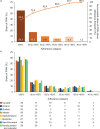Adherence to oral antiretroviral therapy in Canada, 2010-2020
- PMID: 37418513
- PMCID: PMC10552836
- DOI: 10.1097/QAD.0000000000003648
Adherence to oral antiretroviral therapy in Canada, 2010-2020
Abstract
Objective: To assess antiretroviral therapy (ART) adherence among people with HIV (PWH) in Canada and identify baseline characteristics associated with suboptimal adherence (<95%).
Design: Retrospective observational study using data from the National Prescription Drug Utilization Information System and Régie de l'assurance maladie Quebec (RAMQ) Public Prescription Drug Insurance Plan.
Methods: This analysis included PWH aged 18 years or older who initiated an ART regimen and were followed for at least 12 months (2010-2020). Patient characteristics were summarized using medical/pharmacy claims data from seven provinces (Alberta, Manitoba, New Brunswick, Newfoundland and Labrador, Ontario, Saskatchewan, and Quebec). ART regimen at index date (first dispensing of a regimen including a core agent) was defined as a single-tablet or multitablet regimen (MTR). Adherence was calculated using a Proportion of Days Covered approach, based on ART dispensing, recorded between April 2010 and the last available date. Multivariate linear regression analysis was used to determine correlations between suboptimal adherence and baseline characteristics.
Results: We identified 19 322 eligible PWH, 44.7% of whom had suboptimal adherence (<95%). Among 12 594 PWH with evaluable baseline data, 10 673 (84.8%) were ART-naive, 74.2% were men, mean age was 42.9 years, and 54.1% received a MTR as their ART. Based on multivariate regression analysis, suboptimal adherence was significantly associated with multitablet ART ( P < 0.001) and younger age ( P < 0.001) but not sex.
Conclusion: Almost half of adult PWH in Canada had suboptimal adherence to ART. Better understanding of factors influencing adherence may help address gaps in current care practices that may impact adherence.
Copyright © 2023 The Author(s). Published by Wolters Kluwer Health, Inc.
Conflict of interest statement
Conflicts of interest and source of funding: J.B.A. has served on advisory boards and undertaken contract work including clinical research for Viiv Healthcare and Gilead. J.F. received funding from ViiV Healthcare to conduct this study. E.A. and J.K.B. are employees of GSK. J.L. has received research funding from AbbVie Canada, Gilead Canada, GSK Canada, and ViiV Healthcare. V.C. is an employee of ViiV Healthcare Ltd. M.H. has received honoraria, paid to the institution, for consultancy fees and advisory board participation from ViiV Healthcare, Gilead Sciences Canada Inc., and Merck Canada Inc and is an employee of BC Centre for Excellence in HIV/AIDS, Vancouver, BC, Canada.
Figures
References
-
- Bhaskaran K, Hamouda O, Sannes M, Boufassa F, Johnson AM, Lambert PC, Porter K. CASCADE Collaboration. Changes in the risk of death after HIV seroconversion compared with mortality in the general population. JAMA 2008; 300:51–59. - PubMed
-
- Hogg RS, Heath KV, Yip B, Craib KJ, O'Shaughnessy MV, Schechter MT, Montaner JS. Improved survival among HIV-infected individuals following initiation of antiretroviral therapy. JAMA 1998; 279:450–454. - PubMed
-
- Hogg RS, O'Shaughnessy MV, Gataric N, Yip B, Craib K, Schechter MT, Montaner JS. Decline in deaths from AIDS due to new antiretrovirals. Lancet 1997; 349:1294. - PubMed
Publication types
MeSH terms
Substances
LinkOut - more resources
Full Text Sources
Medical
Miscellaneous



